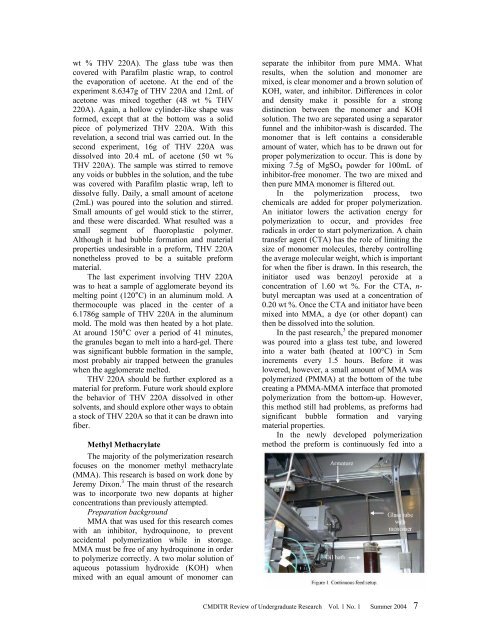CMDITR Review of Undergraduate Research - Pluto - University of ...
CMDITR Review of Undergraduate Research - Pluto - University of ...
CMDITR Review of Undergraduate Research - Pluto - University of ...
You also want an ePaper? Increase the reach of your titles
YUMPU automatically turns print PDFs into web optimized ePapers that Google loves.
wt % THV 220A). The glass tube was then<br />
covered with Parafilm plastic wrap, to control<br />
the evaporation <strong>of</strong> acetone. At the end <strong>of</strong> the<br />
experiment 8.6347g <strong>of</strong> THV 220A and 12mL <strong>of</strong><br />
acetone was mixed together (48 wt % THV<br />
220A). Again, a hollow cylinder-like shape was<br />
formed, except that at the bottom was a solid<br />
piece <strong>of</strong> polymerized THV 220A. With this<br />
revelation, a second trial was carried out. In the<br />
second experiment, 16g <strong>of</strong> THV 220A was<br />
dissolved into 20.4 mL <strong>of</strong> acetone (50 wt %<br />
THV 220A). The sample was stirred to remove<br />
any voids or bubbles in the solution, and the tube<br />
was covered with Parafilm plastic wrap, left to<br />
dissolve fully. Daily, a small amount <strong>of</strong> acetone<br />
(2mL) was poured into the solution and stirred.<br />
Small amounts <strong>of</strong> gel would stick to the stirrer,<br />
and these were discarded. What resulted was a<br />
small segment <strong>of</strong> fluoroplastic polymer.<br />
Although it had bubble formation and material<br />
properties undesirable in a preform, THV 220A<br />
nonetheless proved to be a suitable preform<br />
material.<br />
The last experiment involving THV 220A<br />
was to heat a sample <strong>of</strong> agglomerate beyond its<br />
melting point (120°C) in an aluminum mold. A<br />
thermocouple was placed in the center <strong>of</strong> a<br />
6.1786g sample <strong>of</strong> THV 220A in the aluminum<br />
mold. The mold was then heated by a hot plate.<br />
At around 150°C over a period <strong>of</strong> 41 minutes,<br />
the granules began to melt into a hard-gel. There<br />
was significant bubble formation in the sample,<br />
most probably air trapped between the granules<br />
when the agglomerate melted.<br />
THV 220A should be further explored as a<br />
material for preform. Future work should explore<br />
the behavior <strong>of</strong> THV 220A dissolved in other<br />
solvents, and should explore other ways to obtain<br />
a stock <strong>of</strong> THV 220A so that it can be drawn into<br />
fiber.<br />
Methyl Methacrylate<br />
The majority <strong>of</strong> the polymerization research<br />
focuses on the monomer methyl methacrylate<br />
(MMA). This research is based on work done by<br />
Jeremy Dixon. 3 The main thrust <strong>of</strong> the research<br />
was to incorporate two new dopants at higher<br />
concentrations than previously attempted.<br />
Preparation background<br />
MMA that was used for this research comes<br />
with an inhibitor, hydroquinone, to prevent<br />
accidental polymerization while in storage.<br />
MMA must be free <strong>of</strong> any hydroquinone in order<br />
to polymerize correctly. A two molar solution <strong>of</strong><br />
aqueous potassium hydroxide (KOH) when<br />
mixed with an equal amount <strong>of</strong> monomer can<br />
separate the inhibitor from pure MMA. What<br />
results, when the solution and monomer are<br />
mixed, is clear monomer and a brown solution <strong>of</strong><br />
KOH, water, and inhibitor. Differences in color<br />
and density make it possible for a strong<br />
distinction between the monomer and KOH<br />
solution. The two are separated using a separator<br />
funnel and the inhibitor-wash is discarded. The<br />
monomer that is left contains a considerable<br />
amount <strong>of</strong> water, which has to be drawn out for<br />
proper polymerization to occur. This is done by<br />
mixing 7.5g <strong>of</strong> MgSO 4 powder for 100mL <strong>of</strong><br />
inhibitor-free monomer. The two are mixed and<br />
then pure MMA monomer is filtered out.<br />
In the polymerization process, two<br />
chemicals are added for proper polymerization.<br />
An initiator lowers the activation energy for<br />
polymerization to occur, and provides free<br />
radicals in order to start polymerization. A chain<br />
transfer agent (CTA) has the role <strong>of</strong> limiting the<br />
size <strong>of</strong> monomer molecules, thereby controlling<br />
the average molecular weight, which is important<br />
for when the fiber is drawn. In this research, the<br />
initiator used was benzoyl peroxide at a<br />
concentration <strong>of</strong> 1.60 wt %. For the CTA, n-<br />
butyl mercaptan was used at a concentration <strong>of</strong><br />
0.20 wt %. Once the CTA and initiator have been<br />
mixed into MMA, a dye (or other dopant) can<br />
then be dissolved into the solution.<br />
In the past research, 3 the prepared monomer<br />
was poured into a glass test tube, and lowered<br />
into a water bath (heated at 100°C) in 5cm<br />
increments every 1.5 hours. Before it was<br />
lowered, however, a small amount <strong>of</strong> MMA was<br />
polymerized (PMMA) at the bottom <strong>of</strong> the tube<br />
creating a PMMA-MMA interface that promoted<br />
polymerization from the bottom-up. However,<br />
this method still had problems, as preforms had<br />
significant bubble formation and varying<br />
material properties.<br />
In the newly developed polymerization<br />
method the preform is continuously fed into a<br />
<strong>CMDITR</strong> <strong>Review</strong> <strong>of</strong> <strong>Undergraduate</strong> <strong>Research</strong> Vol. 1 No. 1 Summer 2004 7




